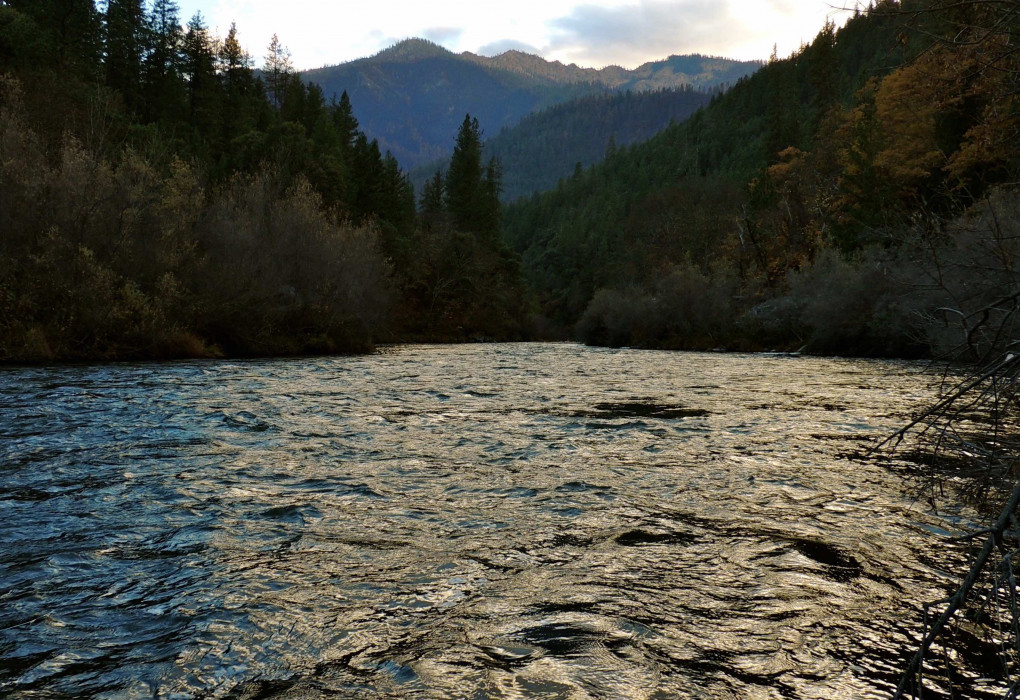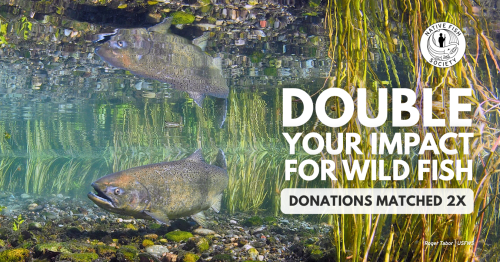Envision A Wild & Free Klamath River
We envision a Klamath River with abundant wild salmon and steelhead that return from the Pacific Ocean with a bounty of marine nutrients, and nourish the river’s human and environmental communities on their journey to spawn near the cold springs of the southern Cascade Mountains.
There is still much work to be done to see that vision come to fruition; although a key milestone was reached late last year when the California State Water Resources Control Board issued a draft Environmental Impact Report of the Klamath River Renewal Corporation’s Definite Plan to decommission the lower four mainstem dams of the Lower Klamath Project (JC Boyle, Copco No 1 & 2, and Iron Gate) in 2021.
To comply with state and federal law the Klamath River Renewal Corporation (KRRC; the non-profit created to remove the dams) must obtain the necessary permits that consider the affected natural resources from decommissioning the project. This environmental review process provides an important opportunity for stakeholders to submit comments on the proposed operations outlined in the Definite Plan.
In February, Native Fish Society and a coalition of conservation groups, businesses, and scientists including Wild Fish Conservancy, Patagonia, Fly Water Travel, Jack Stanford, and Matt Stoecker provided substantive comments on important aspects of the proposed Definite Plan's draft environmental review.
Our message
We fully support decommissioning the Lower Klamath Project — removing these four mainstem dams will improve the biological conditions in the Klamath watershed to benefit sensitive and threatened wild, native fish. Not only is this action critical to the long-term health and resiliency of the Klamath Basin, but also the human and environmental communities these iconic species support.
We also have serious concerns about the significant environmental impacts that would result from the proposed Plan that calls for rebuilding Iron Gate Hatchery, reopening Fall Creek Hatchery with upgraded facilities, and maintaining hatchery operations at both sites for at least eight years after the dams are removed.
Current Operations
Iron Gate Hatchery currently releases a combined 6 million juvenile Chinook and Coho salmon as mitigation to compensate for the spawning and rearing habitat lost between Iron Gate Dam and the Copco Dams, and has an operating budget of about $1.2 million per year. Hatchery steelhead were released until 2013, although the program was terminated due to poor performance and low returns.
Much of the infrastructure associated with Iron Gate Hatchery is tied to Iron Gate Dam, so when the dams are removed the hatchery facilities must be reconstructed and efforts are underway to identify alternative water sources. Given the facilities challenges, the proposed Definite Plan identifies a reduction in hatchery releases for fall Chinook from 6 million smolt and yearling releases to 3.5 million, but maintains the 75,000 yearling Coho program for a conservation approach. While the Coho program has an approved Hatchery Genetic Management Plan, it is unclear what role rebuilding two hatcheries (Iron Gate and Fall Creek) will play in meeting recovery goals, particularly releasing 3.5 million Chinook since current hatchery operations are intended to mitigate for the less than 10 miles of habitat between Iron Gate and Copco dams.
After the dams come down, wild salmon and steelhead will have volitional access to nearly 400 miles of upstream spawning and rearing habitat.
Ongoing Draft Environmental Review
During the environmental impact review required by CEQA, the State Water Board must consider the range of significant environmental impacts and ensure that where possible those impacts are eliminated or mitigated to the extent feasible before issuing a permit.
In July 2018 we submitted comments in the scoping phase of the water quality certification planning, and were pleased to see the State Water Board took our prior comments into consideration with the current review.
The draft environmental review specifically identifies the negative impacts of the hatchery operations outlined in the proposed Definite Plan, including potentially significant impacts that could jeopardize recovery efforts for wild salmon post-dam removal. Importantly, they also consider a “No Hatchery Alternative”, which is the same as the proposed Definite Plan that removes the four mainstem dams, but ceases Iron Gate Hatchery operations at the time of dam removal and does not reopen Fall Creek Hatchery.
The No Hatchery Alternative is the environmentally superior alternative to the proposed Project — it is clearly feasible, mitigates for the known impacts of hatchery operations on wild populations, and meets all of the Project objectives.
Hatchery Impacts
A review of the draft environmental report finds that the “No Hatchery Alternative” has all of the same impacts as the proposed Definite Plan, but will reduce impacts to water quality from effluent discharge (Impact 3.2-17); reduce impacts to aquatic resources by eliminating a source of fish disease; remove well-documented competitive pressure between hatchery and natural origin fish; reduce straying; increase the sustainability of wild fish; reduce impacts to air quality from hatchery emissions; and be more beneficial overall by returning Iron Gate hatchery to more natural conditions (DEIR 4-304 to 4-313).
Given these known risks to wild salmon, it is unclear what role two hatcheries will play in the recovery of wild fish in the Klamath Basin. For instance, a 2013 study of hatchery effects on the Klamath’s wild populations identified “hatchery returns are likely replacing spawners in at least some wild populations in the Klamath basin” and the pattern is most obvious for Chinook (see Quiñones et al., 2013). Likewise, a scientific paper reviewing the most recent science from NOAA/National Marine Fisheries Service regarding hatcheries found that there are “no clear-cut examples in which a reintroduction employing hatchery releases yielded a self-sustaining naturalized population” (Anderson et al, 2014). Importantly, in guidance documents that identify steps to delist a population (the official goal of recovery actions) they make it clear that delisting requires adequate wild and self-sustaining populations (U.S. Fish and Wildlife Service, 1990).
No Hatchery Alternative Impacts
We recognize the draft review identified that a potential negative effect could come from the No Hatchery Alternative — a short-term loss of hatchery fish could impair access for tribal and commercial fishers. We know and understand that salmon are an essential subsistence food for local tribes, including the Yurok, Hoopa, Karuk, and Klamath people who have harvested fish in the Klamath River since time immemorial but are now challenged by poor returns and the lack of a key food source. We also recognize the significance of Klamath salmon to the commercial fishing industry, and the economic losses the industry has taken in recent years due to poor salmon returns that constrain commercial fisheries.
It is important that tribal, commercial, recreational fishing interests, as well as the animal communities that depend on the return of marine-derived nutrients to the river, are not significantly impacted by the loss of hatchery fish compared to existing conditions.
Notably, the draft environmental review finds that any short-term impacts from the loss of hatchery fish would be offset by improved conditions for native fish, which will increase the numbers of wild salmon available for harvest and lessen the restrictions on commercial fisheries in the future. Further, the No Hatchery Alternative would be more beneficial and quicker than the proposed Definite Plan. A stated goal of dam removal is achieving the long-term survival of wild, native fish and advancing restoration of the salmonid fisheries in the Klamath Basin.
Removing hatchery fish will relieve competition with wild salmon, as well as reduce chemicals and other pollutants that enter the river from hatchery operations. In addition, hatchery salmon are significant vectors for parasites, attract predators, directly compete with wild fish for food and space, and are less adapted than their wild counterparts (see DEIR 4-304 to 4-313).
We also know that continuing to release hatchery salmon as the river and its native fish heal will compromise dam removal and recovery efforts, spend limited public dollars on projects that do not meet recovery goals, and jeopardize threatened and sensitive populations of salmon that are already imperiled.
Given the significant investment to remove the lower four mainstem dams to benefit salmon in the Klamath River, the opportunity cost of spending limited financial resources on rebuilding hatcheries seems at cross-purposes the goal of re-establishing the long term viability of wild, native fish.
Other Needs
Dam removal is an important step to recover the Klamath River’s wild salmon and steelhead, but it’s not the only action that will ensure they are resilient and can meet the challenges of a changing climate. Under the Klamath Hydropower Settlement Agreement, the previous dam owners PacifiCorp agreed to fund hatchery facilities and 8 years of hatchery operations and maintenance up to $1.25 million per year. For comparison, PacifiCorp provides $510,000 annually to a Coho Enhancement Fund that supports habitat restoration and acquisition, but will only remain in effect until the time of project decommissioning.
The KHSA is an important agreement that has set the stage for dam decommissioning. Today, given the overwhelming scientific literature identifying the known risks of hatchery programs on wild populations and the intended goals of dam removal, it is difficult to reconcile the large financial investment in new hatchery infrastructure when there are other important needs that would contribute to self-sustaining populations.
For example, it is important to ask, what could it look like to have $13.68 million of investment over 8 years (the PacifiCorp hatchery obligation and continuing the Coho Enhancement Fund) plus the cost of upgrading Iron Gate and Fall Creek hatchery facilities for actions that would contribute to self-sustaining populations of wild salmon?
Other needs have been identified and should be prioritized over continuing hatchery operations, such as improving water quality, maintaining instream flows, investing in fish protection screens across newly accessible habitat, restoring degraded habitat, replanting streamside vegetation, expanding livestock exclusions, protecting cold-water refugia, and investing in land conservation in the upper basin’s most suitable habitat, to name a few of the needs the Klamath watershed is facing.
The best hatchery is a healthy river, and we’re all one step closer to making that a reality on the Klamath River in 2021. We hope you join with us and share our vision by voicing support for this incredible restoration event to save imperiled wild salmon and steelhead, while also addressing the need to focus on actions that will meaningfully contribute to abundant wild salmon and steelhead in the Klamath River.

